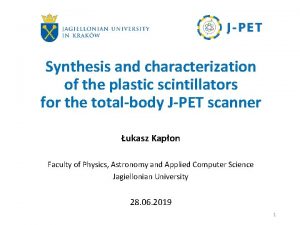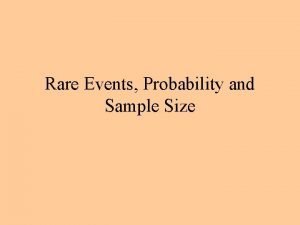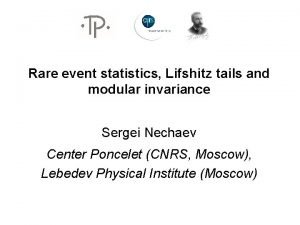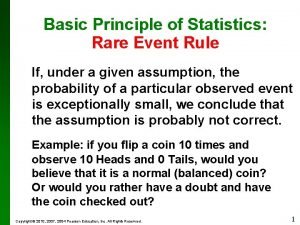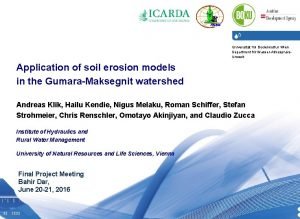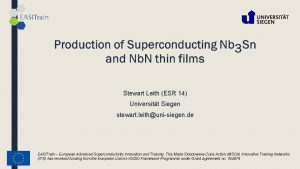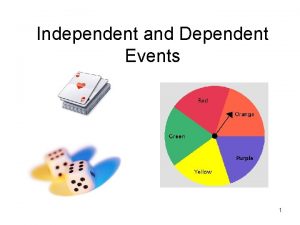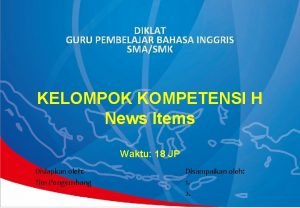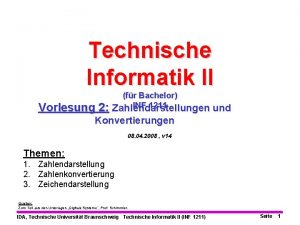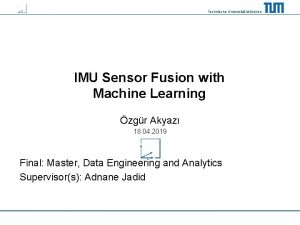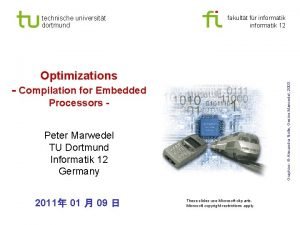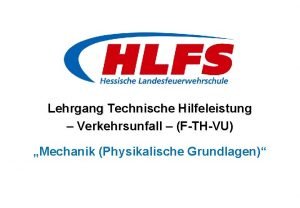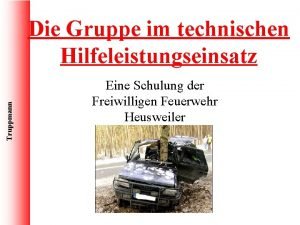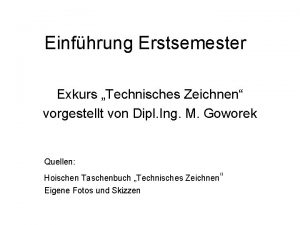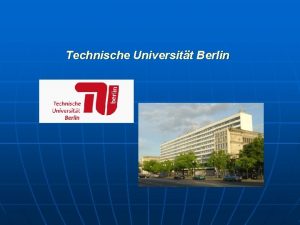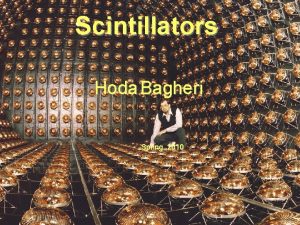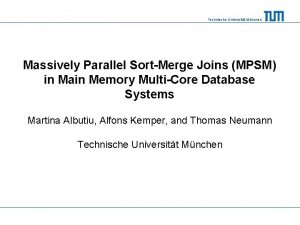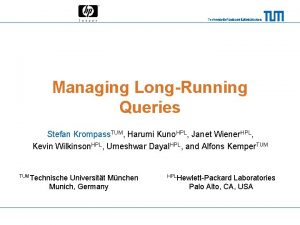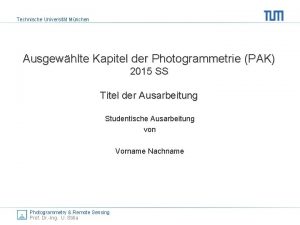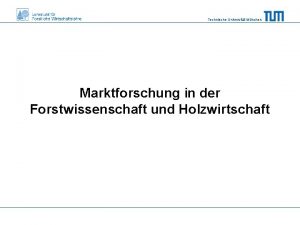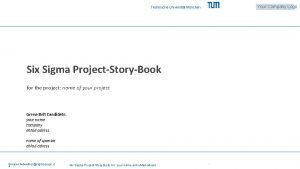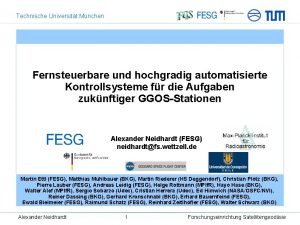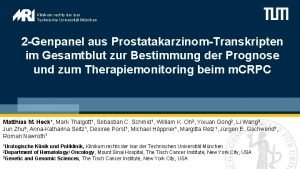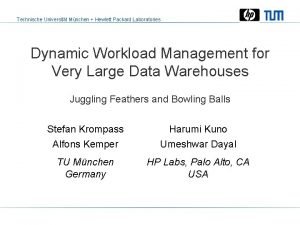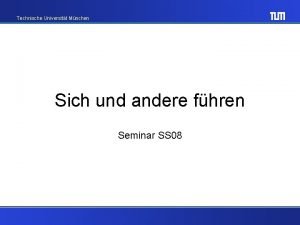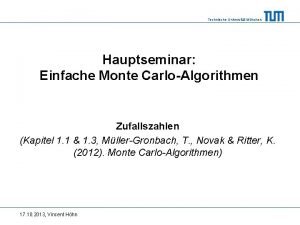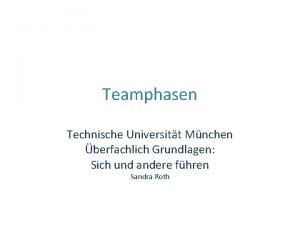Technische Universitt Mnchen Inorganic Scintillators for Rare Event






















- Slides: 22

Technische Universität München Inorganic Scintillators for Rare Event Searches M. v. Sivers, JAPS 15. 11. 2013

Technische Universität München Rare Event Searches with Scintillators Experiment Scintillator Physics Technique Status Site CRESST-II Ca. WO 4 Dark Matter Bolometer Running LNGS, Italy DAMA/LIBRA Na. I Dark Matter Standard Running LNGS, Italy KIMS Cs. I, Na. I Dark Matter Standard Running Y 2 L, Korea TEXONO Cs. I Neutrino physics Standard Running KSNL, Taiwan CANDLES Ca. F 2 0ν 2β Standard R&D Kamioka, Japan DM-Ice Na. I Dark Matter Standard R&D South Pole ANAIS Na. I Dark Matter Standard R&D LSC, Spain KAMLAND-Pico Na. I Dark Matter Standard R&D Kamioka, Japan SABRE Na. I Dark Matter Standard R&D LNGS, Italy/SNOLab, Canada (? ) LUCIFER Zn. Se 0ν 2β Bolometer R&D LNGS, Italy (? ) LUMINEU Zn. Mo. O 4 0ν 2β Bolometer R&D LSM, France (? ) AMORE Ca. Mo. O 4 0ν 2β, Dark Matter Bolometer R&D Y 2 L, Korea M. v. Sivers, JAPS 15. 11. 2013

Technische Universität München Standard Scintillation Detectors vs. Bolometers • Standard scintillation detector • – Crystal at RT, scintillation light detected by PMT – Particle identification by pulseshape possible Crystal PMT Scintillating bolometer – Crystal at m. K temperature equipped with thermal sensor (phonon channel) – Scintillation light detected by e. g. Si/Ge waver with thermal sensor (light channel) – Particle identification by light/phonon ratio e--recoils O-recoils M. v. Sivers, JAPS 15. 11. 2013

Technische Universität München Ca. WO 4 Crystals • In house production at TUM since 2011 Ø Very good radiopurity was achieved: total α-activity (1 -3 m. Bq/kg) • • Light Yield: 40% of Na. I(Tl) at RT, 1. 7 x increase at low temperatures Multi-material target for DM – W (A=184): Good sensitivity for coherent scattering (σcoh~A 2) – Ca, O: Sensitivity to light WIMPs – 183 W (14%): some sensitivity to spin-dependent scattering Isotope Natural abundance Decay mode Q-value 48 Ca 0. 18% 2β- 4274 ke. V 46 Ca 0. 004% 2β- 988 ke. V 40 Ca 96. 9% 2 EC 194 ke. V 180 W 0. 13% 2 EC 144 ke. V 186 W 28. 4% 2β- 490 ke. V M. v. Sivers, JAPS 15. 11. 2013

Technische Universität München CRESST-II • Dark Matter search with Ca. WO 4 scintillating bolometers Ø Discrimination between electron and nuclear recoils by phonon-light technique • Observation of 67 candidate events in 730 kg days of data (2011) Ø Maximum Likelihood analysis favored signal over background-only hypothesis with significance >4σ Ø But large contribution from background demands further clarification Eur. Phys J. C, 72: 1971 (2012) M. v. Sivers, JAPS 15. 11. 2013

Technische Universität München CRESST-II • New run started July 2013 Ø Detector mass doubled Ø Improved background situation due to cleaner materials and new detector designs • Analysis for double beta processes and low-threshold Dark Matter analysis ongoing M. v. Sivers, JAPS 15. 11. 2013

Technische Universität München Na. I(Tl) Crystals • • • Most commonly used scintillator established technique High Light Yield (≈45, 000 ph/Me. V) 23 Na (100%): Sensitivity for light WIMPs and spin-dependent interactions 127 I (100%): Good sensitivity for coherent scattering and spin-dependent interactions Main background for Dark Matter search: 3 ke. V x-ray from EC decay of 40 K M. v. Sivers, JAPS 15. 11. 2013

Technische Universität München DAMA/LIBRA • Dark Matter search with 250 kg of Na. I(Tl) – 2 ke. V threshold (5. 5 -7. 5 phe/ke. V), background rate 1 cpd/ke. V/kg (13 ppb of nat. K) – Positive signal for annual modulation with 8. 9σ measured over 13 annual cycles – Fit to rate of single hits between 2 -6 ke. V with Acos[ω(t-t 0)] gives A=(0. 0116± 0. 0013)cpd/kg/ke. V, ω=(0. 999± 0. 002)yr, t 0=(146± 7)d (t 0=152. 5 d expected for DM) – No modulation in multiple hits, no modulation above 6 ke. V – WIMP parameter space excluded by several other experiments But no model-independent check of signal with same target material up to now Eur. Phys. J. C, 67: 39 -49 (2010) Phys. Lett. B 616: 17 -24 (2005) NAIAD DAMA M. v. Sivers, JAPS 15. 11. 2013

Technische Universität München DM-Ice • 250 kg of Na. I(Tl) deployed in Ice. Cube detector – Goal: Check DAMA claim on southern hemisphere – 17 kg of NAIAD crystals as prototype running since 2011 • Current background 7 x higher then DAMA (650 ppb nat. K) Ø R&D for crystal growth ongoing, pushing threshold below 4 ke. V Astropart. Phys. 35 (2012) 749 -754 M. v. Sivers, JAPS 15. 11. 2013

Technische Universität München ANAIS • Dark Matter search with 250 kg of Na. I(Tl) – 25 kg prototype running since Dec. 2012 Ø 40 ppb of nat. K (3 x higher than DAMA) Ø High light collection 12 -16 phe/ke. V without lightguides (2 x higher than DAMA) Ø R&D on crystal growth ongoing (goal <20 ppb nat. K) ar. Xiv: 1308. 3478 M. v. Sivers, JAPS 15. 11. 2013

Technische Universität München SABRE • Dark Matter search with 100 kg of Na. I(Tl) crystals in liquid scintillator (LAB) veto – – Purchased 8 kg of Na. I powder with 12 ppb/3. 5 ppb nat. K First step: measure 40 K concentration in crystals with liquid scintillator coincidence Second step: Move chamber to LNGS or SNOLab for DM run Expected background rate 0. 39 cpd/kg/ke. V (2. 5 x lower than DAMA) See Talk by E. Shields at TAUP 2013 M. v. Sivers, JAPS 15. 11. 2013

Technische Universität München Cs. I(Tl) Crystals • • • High Light Yield: 60, 000 ph/Me. V 127 I, 133 Cs: Good sensitivity for coherent scattering and spin-dependent interactions Pulseshape discrimination possible @3 ke. V M. v. Sivers, JAPS 15. 11. 2013

Technische Universität München KIMS • Dark Matter search with 100 kg of Cs. I(Tl) – Light yield 5 phe/ke. V, background rate 2 -4 cpd/kg/ke. V – Total exposure 24. 5 ton days – Excludes DAMA signal as WIMP scattering on iodine • Annual modulation analysis with 2. 5 years (75. 5 ton days) data – amplitude <0. 0122 cpd/kg/ke. V at 90%CL (DAMA signal 0. 0116± 0. 0013 cpd/kg/ke. V) PRL 108, 181301 (2012) M. v. Sivers, JAPS 15. 11. 2013

Technische Universität München Ca. F 2 Crystals • • Light Yield: 24, 000 ph/Me. V (Ca. F 2(Eu)) 48 Ca (0. 18%): 0ν 2β candidate with highest Q-value (4. 27 Me. V) – Enrichment difficult (no gaseous Ca compunds): 1 g of 48 Ca costs $100 k • • 19 F (100%): Sensitivity to spin-dependent interactions Pulseshape discrimination possible Isotope Natural abundance Decay mode Q-value 46 Ca 0. 004% 2β- 988 ke. V 40 Ca 96. 9% 2 EC 194 ke. V M. v. Sivers, JAPS 15. 11. 2013

Technische Universität München CANDLES III • Search for 0ν 2β with 305 kg Ca. F 2(pure) in liquid scintillator veto – Best limit on 0ν 2β of 48 Ca from predecessor ELEGANT VI (exposure 4. 23 kg yrs): T 1/2>1. 4 e 22 y (Nucl. Phys. A 730 (2004) 215– 223) – R&D on enrichment of 48 Ca: chemical processing with crown ether, Laser separation See talk by Umehara at TAUP 2013 M. v. Sivers, JAPS 15. 11. 2013

Technische Universität München Zn. Se Crystals • • • 82 Se (7. 8%): Candidate for 0ν 2β (Q-value 2996 ke. V) High radiopurity: 17μBq/kg (226 Ra, 232 Th) Light Yield at low temperature: 7. 4 ke. V/Me. V (Ca. WO 4: 20 ke. V/Me. V) Pulseshape discrimination possible Inverse quenching factor (LYα/LYγ=4. 2) not yet understood alphas gammas Isotope Natural abundance Decay mode Q-value 64 Zn 49. 2% 2 EC, ECβ+ 1096 ke. V 70 Zn 0. 61% 2β- 999 ke. V 74 Se 0. 89% 2 EC, ECβ+ 1210 ke. V M. v. Sivers, JAPS 15. 11. 2013

Technische Universität München LUCIFER • Search for 0ν 2β with Zn 82 Se scintillating bolometers – Good energy resolution (13 ke. V@2615 ke. V) – Discrimination of alphas with phonon-light technique and PSD • • Sensitivity goal of <mν>=100 me. V: 10 kg of 95% enriched 82 Se, 5 years exposure, <10 -3 counts/kg/ke. V/y, 5 ke. V resolution Possibility to also search for DM ar. Xiv: 1303. 4080 Astropart. Phys. 34: 344 -353 (2011) M. v. Sivers, JAPS 15. 11. 2013

Technische Universität München Zn. Mo. O 4 Crystals • • • 100 Mo (9. 6%): Candidate for 0ν 2β (Q-value 3034 ke. V) Low Light Yield at low temperatures: 1 ke. V/Me. V High radiopurity: <32μBq/kg (226 Ra, 228 Th) Isotope Natural abundance Decay mode Q-value 64 Zn 49. 2% 2 EC, ECβ+ 1096 ke. V 70 Zn 0. 61% 2β- 999 ke. V 92 Mo 14. 8% 2 EC, ECβ+ 1659 ke. V M. v. Sivers, JAPS 15. 11. 2013

Technische Universität München LUMINEU • Search for 0ν 2β with Zn 100 Mo. O 4 scintillating bolometers – Good energy resolution (5. 7 ke. V@2615 ke. V) – Discrimination of alphas with phonon-light technique and PSD (discr. power 20σ!) • • • Sensitivity goal of <mν>=100 me. V: 30 kg of 90% enriched detectors, 5 years exposure, ≈1. 5*10 -3 counts/kg/ke. V/y, 5 ke. V resolution Main background from pileup of 2ν 2β: development of faster detectors Collaboration with TUM to grow high purity Zn. Mo. O 4 crystals ar. Xiv: 1202. 0238 M. v. Sivers, JAPS 15. 11. 2013

Technische Universität München Ca. Mo. O 4 Crystals • • Highest Light Yield among molybdates: 30, 000 ph/Me. V (at low temp. ) For 0ν 2β of 100 Mo (Q-value 3034 ke. V) 2ν 2β of 48 Ca (Q-value 4270 ke. V) serves as background High radiopurity: ≈80μBq/kg (226 Ra, 228 Th) Pulseshape discrimination possible Isotope Natural abundance Decay mode Q-value 46 Ca 0. 004% 2β- 988 ke. V 40 Ca 96. 9% 2 EC 194 ke. V 92 Mo 14. 8% 2 EC, ECβ+ 1659 ke. V M. v. Sivers, JAPS 15. 11. 2013

Technische Universität München AMORE • Search for 0ν 2β with 40 Ca 100 Mo. O 4 scintillating bolometers (depleted in 48 Ca) – Discrimination of alphas with phonon-light technique and PSD – Good energy resolution (11. 2 ke. V@5. 5 Me. V) • • Sensitivity goal <mν>=20 -60 me. V: 250 kg yrs exposure Possibility to also search for Dark Matter (AMORE-DARK) See talk by Y. Kim at RPScint 13 M. v. Sivers, JAPS 15. 11. 2013

Technische Universität München Summary • Inorganic scintillators – Key properties for rare event searches: Radiopurity, Light Yield – Advantages: • Wide choice of materials • Multimaterial approach: – Simultaneous sensitivity to spin-dependent and coherent interactions/light and heavy WIMPs – Possibility to study many rare decays in one experiment (e. g. 2β, 2 EC, ECβ+, …) – Disadvantages: • Crystal growth is extensive, especially for ton-scale experiments • No purification possible after crystal growth • Scintillating bolometers – Very good energy resolution – Active background discrimination with phonon-light technique – Promising for next generation 0ν 2β experiments (zero background seems feasible) M. v. Sivers, JAPS 15. 11. 2013
 Plastic scintillators: chemistry and applications
Plastic scintillators: chemistry and applications Rare event rule for inferential statistics
Rare event rule for inferential statistics Rare events
Rare events Rare event rule statistics
Rare event rule statistics What is the rare event rule in statistics
What is the rare event rule in statistics Universitt
Universitt Harvard universitt
Harvard universitt Ccc freiburg
Ccc freiburg Universitt wien
Universitt wien Independent event vs dependent event
Independent event vs dependent event What does sentinel event mean
What does sentinel event mean Event management content
Event management content Simple event and compound event
Simple event and compound event General structure of news item
General structure of news item Newsworthy event background event source
Newsworthy event background event source Independent or dependent
Independent or dependent Technische informatik 2 tu bs
Technische informatik 2 tu bs Technische universität münchen (tum)
Technische universität münchen (tum) Technische graphics
Technische graphics Schubkarre hebelgesetz
Schubkarre hebelgesetz Wassertrupp aufgaben
Wassertrupp aufgaben Din 31 051
Din 31 051 Zentrierbohrung iso 6411
Zentrierbohrung iso 6411
